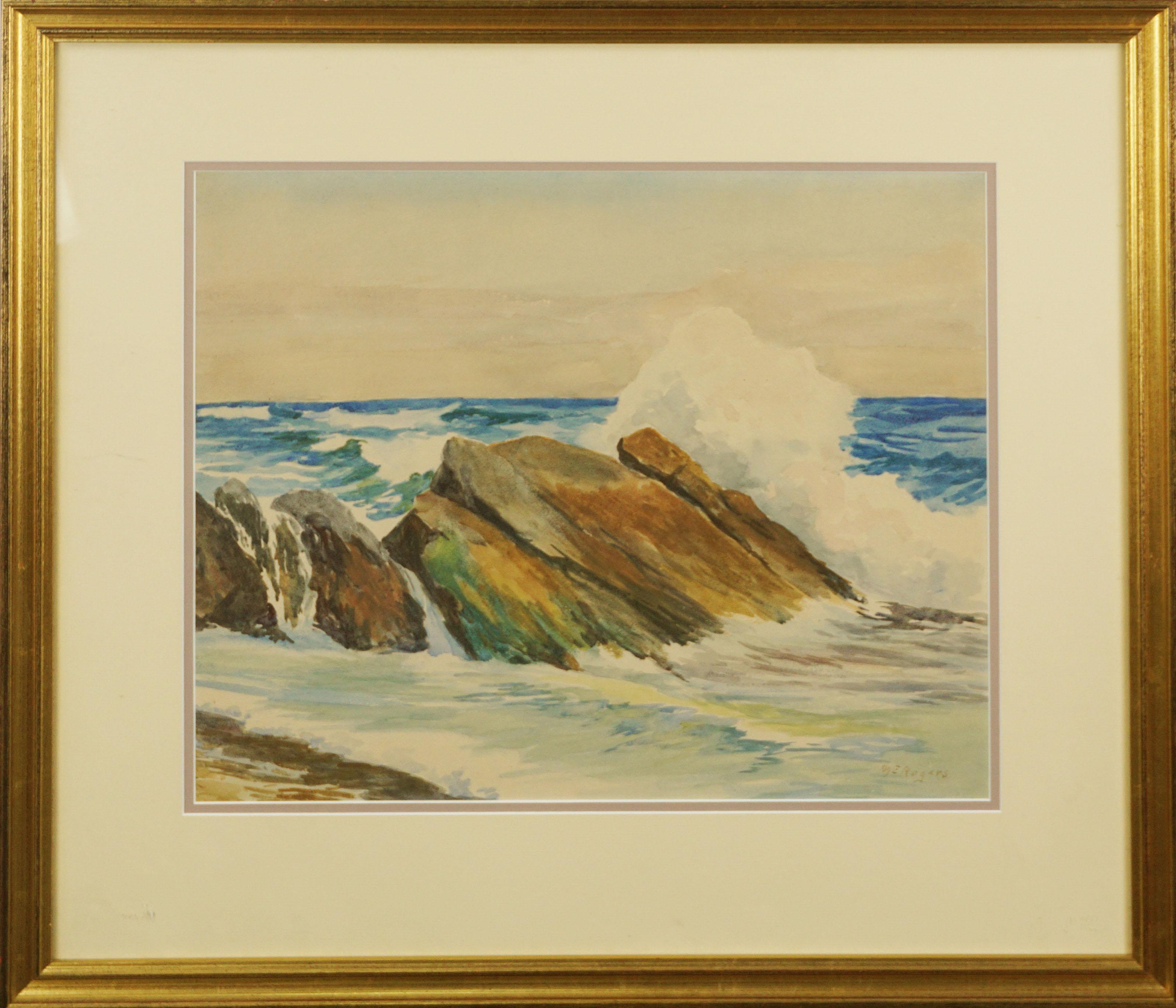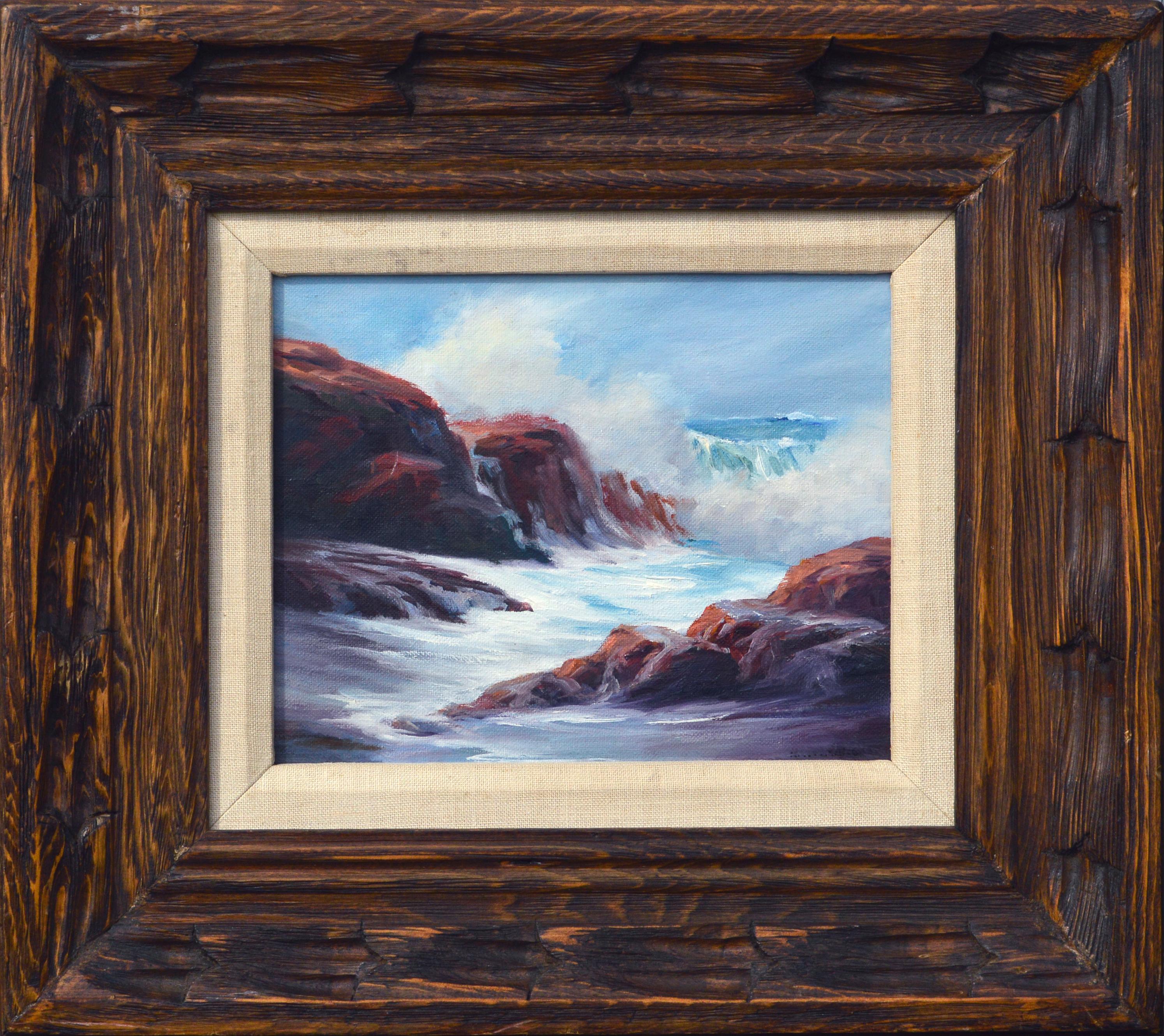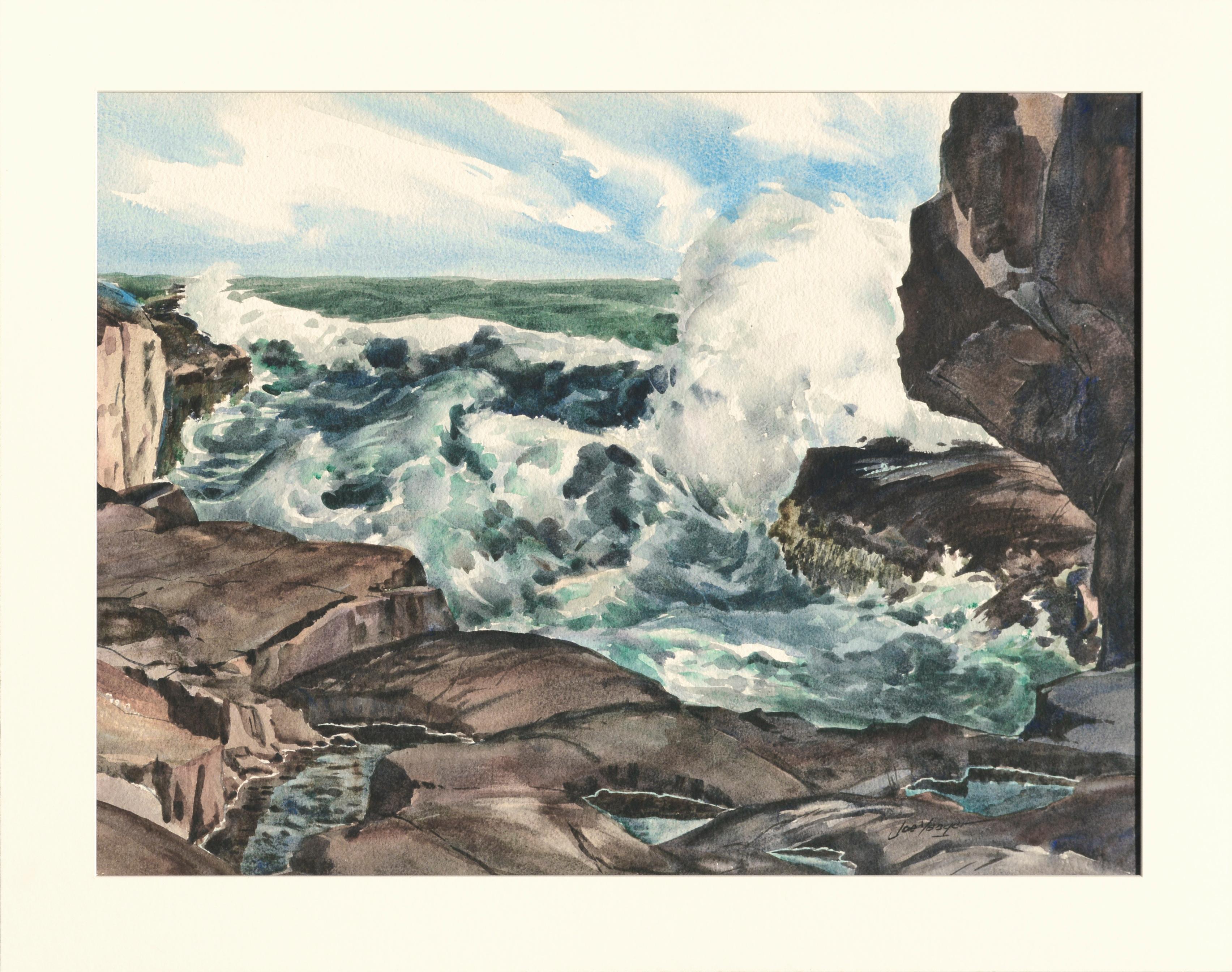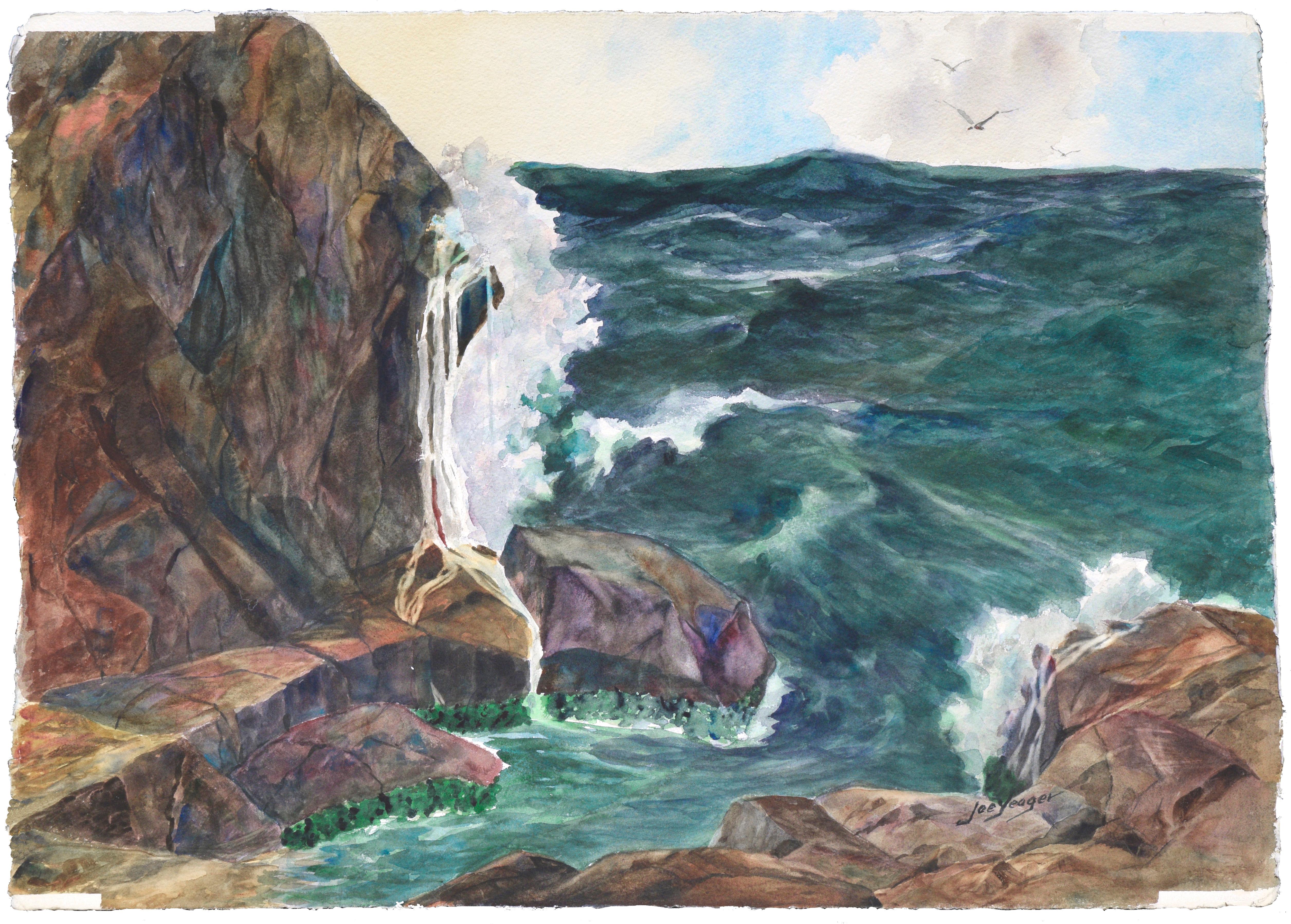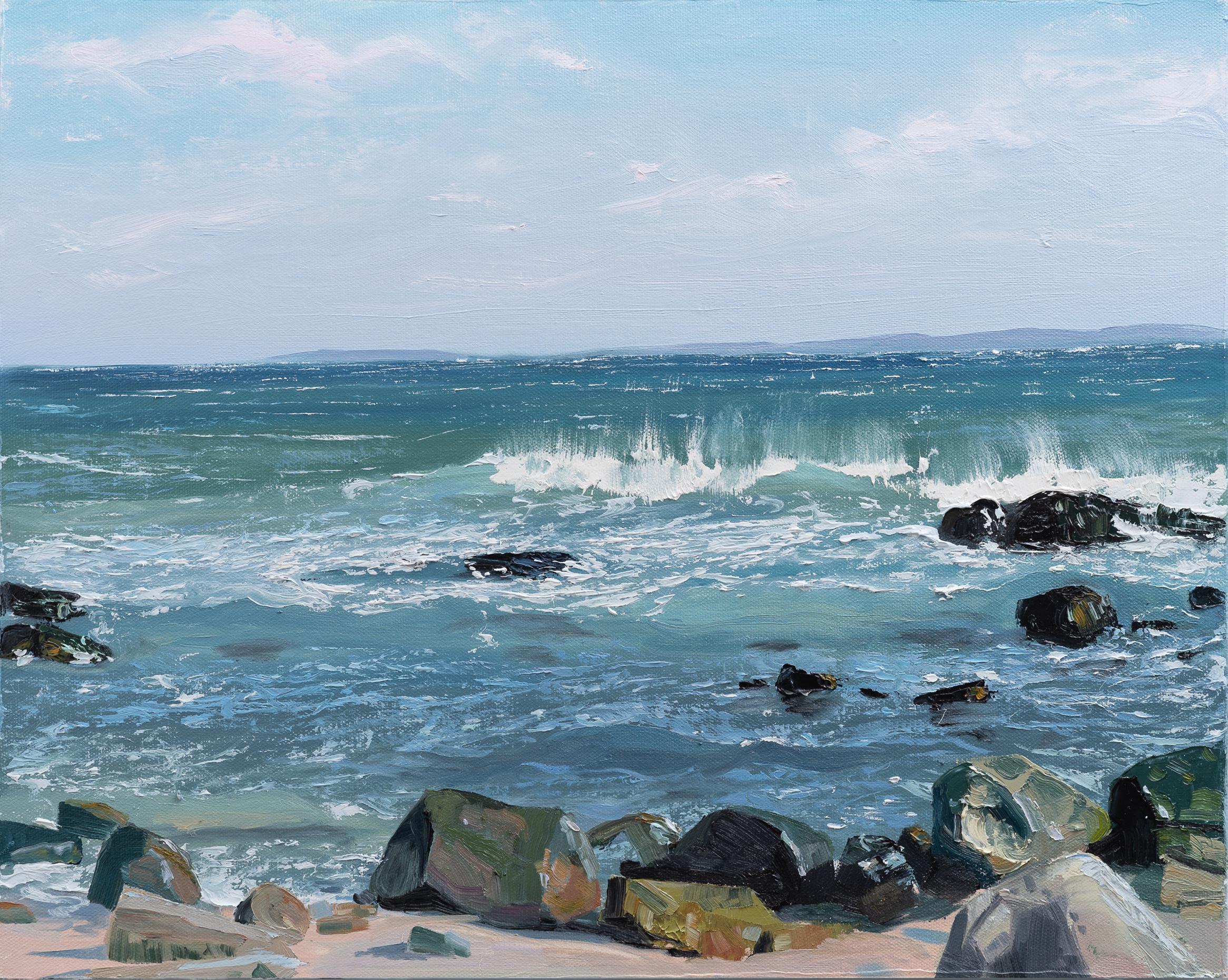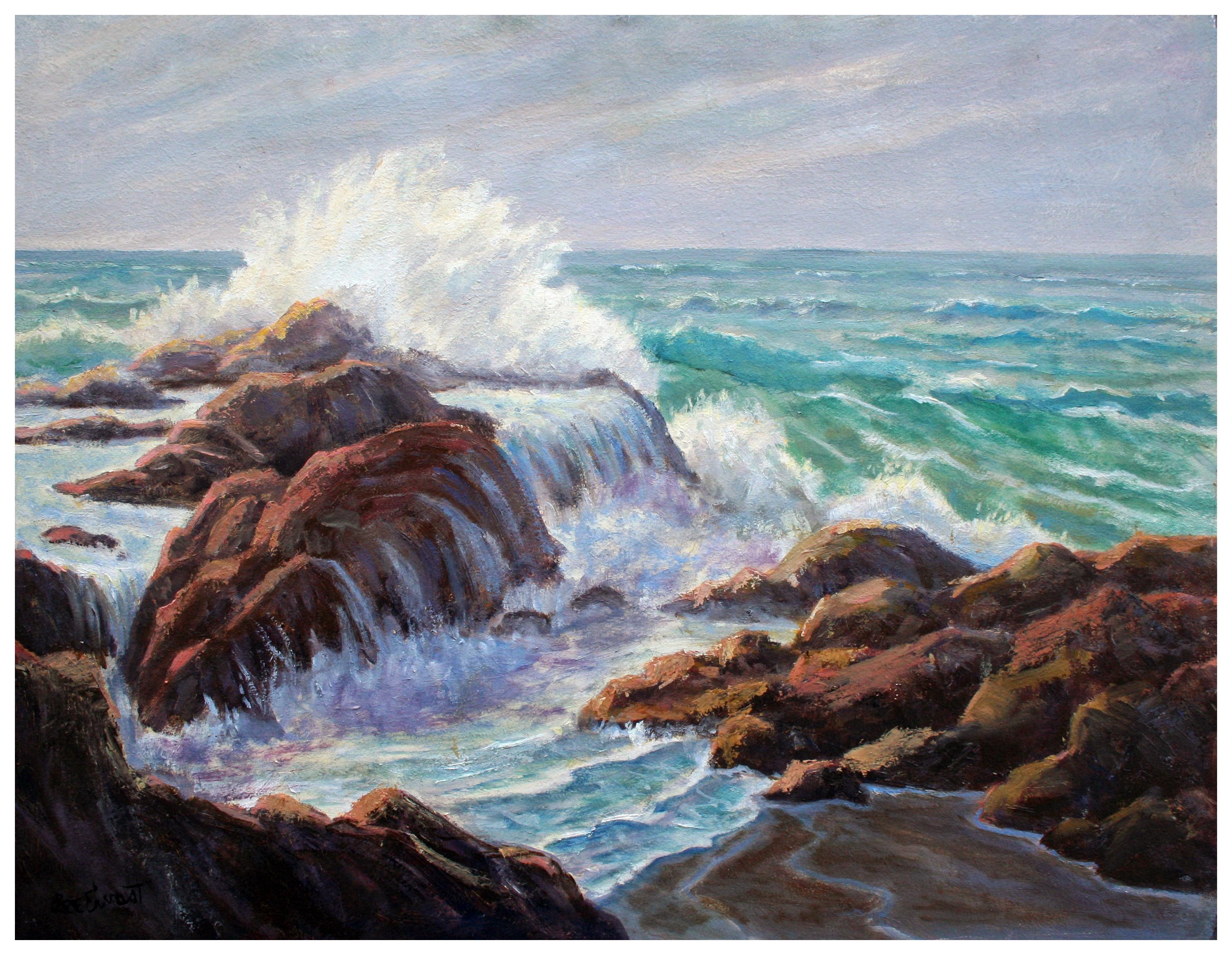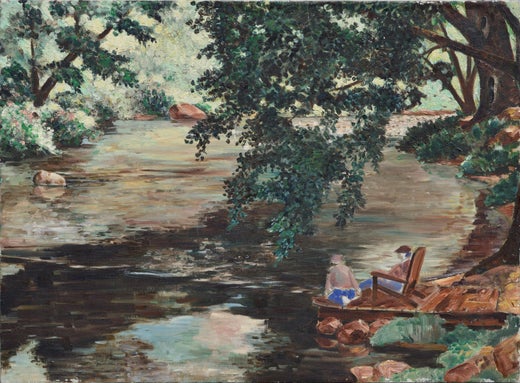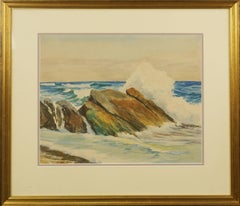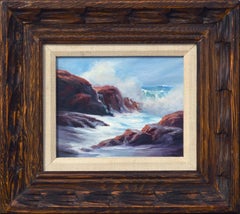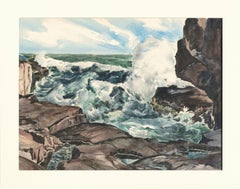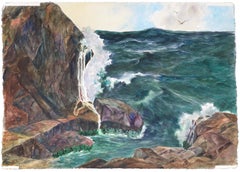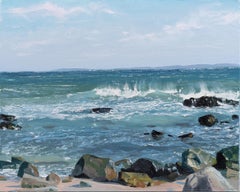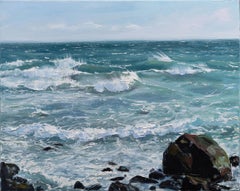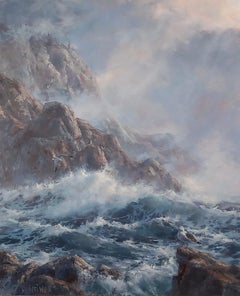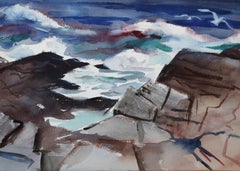Items Similar to Waves Crashing on the Rocks Landscape
Want more images or videos?
Request additional images or videos from the seller
1 of 10
Joseph YeagerWaves Crashing on the Rocks Landscapec.1970
c.1970
$1,200
$1,50020% Off
£916.68
£1,145.8520% Off
€1,053.17
€1,316.4720% Off
CA$1,715.74
CA$2,144.6820% Off
A$1,890.35
A$2,362.9420% Off
CHF 978.56
CHF 1,223.2020% Off
MX$22,760.28
MX$28,450.3520% Off
NOK 12,390.92
NOK 15,488.6520% Off
SEK 11,640.48
SEK 14,550.6120% Off
DKK 7,863.96
DKK 9,829.9420% Off
About the Item
Dynamic and energetic watercolor of waves crashing into coastal rocks by Joe Yeager (American, 20th Century). Signed in the lower right corner by the artist. Presented in a double mat of brown and off-white, as well as a modern gold colored frame. Image size: 14.75"H x 22.75"W
Joseph "Joe" Yeager (American, 20th Century) was raised in Cleveland Ohio, where he went to art school at night and started his art career at 19. He was a commercial artist for the Cleveland Press for seven years, and then worked as the paper’s art director for another seven. In the army, he was a technical research illustrator for the National Advisory Committee for Aeronautics. He later moved to Medina, Ohio in 1941 and opened Joe Yeager Industrial Design in 1947. He also taught advanced perspective at the Cleveland School of Art.
- Creator:Joseph Yeager (1892 - 1958, American)
- Creation Year:c.1970
- Dimensions:Height: 21.25 in (53.98 cm)Width: 27.25 in (69.22 cm)Depth: 0.75 in (1.91 cm)
- Medium:
- Movement & Style:
- Period:
- Condition:
- Gallery Location:Soquel, CA
- Reference Number:Seller: JT-DBH54791stDibs: LU5424159871
Joseph Yeager
Joseph "Joe" Yeager was raised in Cleveland, Ohio, where he went to art school at night and started his art career at 19. He was a commercial artist for the Cleveland Press for seven years, and then worked as the paper’s art director for another seven. In the army, he was a technical research illustrator for the National Advisory Committee for Aeronautics. Yeager later moved to Medina, Ohio, in 1941, and opened Joe Yeager Industrial Design in 1947. He also taught advanced perspective at the Cleveland School of Art.
(Biography provided by Robert Azensky Fine Art)
About the Seller
5.0
Platinum Seller
Premium sellers with a 4.7+ rating and 24-hour response times
Established in 1986
1stDibs seller since 2014
3,014 sales on 1stDibs
Typical response time: <1 hour
- ShippingRetrieving quote...Shipping from: Soquel, CA
- Return Policy
Authenticity Guarantee
In the unlikely event there’s an issue with an item’s authenticity, contact us within 1 year for a full refund. DetailsMoney-Back Guarantee
If your item is not as described, is damaged in transit, or does not arrive, contact us within 7 days for a full refund. Details24-Hour Cancellation
You have a 24-hour grace period in which to reconsider your purchase, with no questions asked.Vetted Professional Sellers
Our world-class sellers must adhere to strict standards for service and quality, maintaining the integrity of our listings.Price-Match Guarantee
If you find that a seller listed the same item for a lower price elsewhere, we’ll match it.Trusted Global Delivery
Our best-in-class carrier network provides specialized shipping options worldwide, including custom delivery.More From This Seller
View AllMid Century Crashing Surf on Rocks Seascape
By Margaret Esther Rogers
Located in Soquel, CA
Classic mid-century California seascape watercolor of the crashing surf on the rocky coast by Santa Cruz, California artist Margaret E. Rogers (American, 1872-1961), c.1950. Rogers was one of the original "Jolly Daubers" who studied with Frank Heath and took wagon trips to the redwoods and Yosemite to paint.
Signed "M.E. Rogers" lower right.
Presented in a rustic giltwood frame under glass.
Image, 16.5"H x 18.5"L.
Margaret Esther Rogers' (1872 - 1961) early childhood was spent in England. The Rogers were a cultured family who came to California for the father’s health and settled on a ranch in the King City area. Margaret grew up in the curiously paradoxical world of early California, breaking her own riding horses and roping cattle during the day, doing a man’s work, riding a man’s saddle, then sitting down to the piano to play classics in the evening after high tea. Margaret’s mother had the only piano for 80 miles around. Her father, Robert J. Rogers, had been an importer of fine tea, coffee, and spices in England. In Monterey County, he raised sheep and cattle and the family lived under comparatively rustic and modest conditions. When Margaret wasn’t riding, tending a herd, plowing a field, or playing the piano, she was painting. Art was an early love.
Fame caught up with her early. She was written up in a San Francisco newspaper as “Monterey County’s pretty girl who rides a man’s saddle, marks and brands stock, breaks wild colts, plows and sows, plays classical music and paints in oils.” Margaret’s mother was her first music and art teacher; later she took art lessons from Kate Baldwin in Salinas.
She had suitors and several proposals, but never married. In the year 1898, Margaret’s “intended” put in 700 acres of grain, spending all he had plus money he borrowed. Not a spear of grain grew, she wrote, and their plans to marry when the crop was sold dried up with the weather.
When her mother died, Margaret and her father moved to Soquel, taking along her favorite saddle horse. Now living in Santa Cruz County, Margaret at once became involved in art circles which were unofficially headed by Frank Heath and his wife, Lillian Dake Heath. Frank Heath and Margaret together founded Santa Cruz Art League in 1919, and a few months later were joined in their efforts by a Dutch woman named Cor de Gavere who arrived in Santa Cruz.
The two women artists, Margaret and Cor, became fast friends and remained so until Cor’s death in July 1955, while she was visiting relatives in Holland. They painted together almost every day and shared many meals at each other’s cottages which were just a few blocks apart in the Seabright area. However, those Victorian ladies, raised in the era of rigid social conventions, always addressed each other as ‘Miss Rogers’ and ‘Miss de Gavere’ as long as they lived. Money was never in great supply for either lady, but Cor managed to buy a small automobile, and after six driving lessons the two of them took off for southern California. Cor and Margaret took many camping and painting trips in Cor’s automobile. Sometime later, Margaret herself got brave enough to buy an auto.
From 1925 to 1947, Margaret made her home in the basement of the Arts and Crafts Building. She managed the Art League’s first gallery, which was started there. Holding informal court for friends who called, Margaret would open a can of sardines, put out a plate of crackers, and conversation about art or music would follow. During World War II, Margaret raised rabbits in cages. In later years, Margaret purchased a small studio-home on Alhambra Street – still in the Seabright area, which both women clung to as home territory.
In 1929, Margaret helped found the Art League’s first Statewide Show, which became an annual event. She served as show chairwoman for more than 20 years. A fine painter of landscapes, Margaret became better known for her strong marine scenes. Once she explained that the ocean was “the real challenge, because it won’t stand still.” She served as president of the Art League from 1925 to 1947. Short, stocky, outspoken and very talented, Margaret gained many honors in her later years. With her short haircut and her dark dresses...
Category
1950s American Impressionist Landscape Drawings and Watercolors
Materials
Paper, Watercolor
$1,000 Sale Price
20% Off
Waves Crashing on the Cliffs Seascape
By Henry Cusimano
Located in Soquel, CA
Dynamic oil painting of waves crashing against red cliffs by Henry Cusimano (American, 1937-2014). Signed by the artist indistinctly in the lower right ...
Category
Early 2000s American Impressionist Landscape Paintings
Materials
Canvas, Oil, Cardboard
$1,080 Sale Price
20% Off
Bass Rocks in Cape Ann, Massachusetts - Seascape
By Joseph Yeager
Located in Soquel, CA
Seascape of tide pools and crashing waves by Joseph Yeager (early-mid 20th Century) on heavy bond watercolor paper with ragged edges. Signed "Joe Yeager" in the lower right corner. "...
Category
Mid-20th Century American Realist Landscape Drawings and Watercolors
Materials
Paper, Watercolor
$1,020 Sale Price
20% Off
Mid Century Seascape - Pacific Ocean Waves and Cliff Watercolor
By Joseph Yeager
Located in Soquel, CA
One out of many in a series of vibrant mid century watercolor ocean seascapes by Joseph Yeager (American, 1892-1958), featuring deep turquoise ocean waves crashing against a rocky cliffside cove, on heavy bond Arches watercolor paper, c.1940s. Signed "Joe Yeager...
Category
Mid-20th Century American Impressionist Landscape Drawings and Watercolors
Materials
Paper, Watercolor
$780 Sale Price
20% Off
Crashing Waves - Mid Century California Seascape
Located in Soquel, CA
Gorgeous mid-century seascape of turquoise and lavender waves crashing on coastal rocks by California artist Lee Ervast (American, 1916 - 1975), c.1950s. Si...
Category
1960s American Impressionist Landscape Paintings
Materials
Masonite, Oil
$700 Sale Price
20% Off
Rocks in the Tide, Miniature Contemporary Coastal Seascape
By Kathleen Murray
Located in Soquel, CA
Vibrant miniature seascape by Kathleen Murray (American, b. 1958). Signed in lower right corner. Unframed. Image, 8"H x 6"W.
Kathleen Murray (American, b. 1958) was born in Los Ange...
Category
2010s American Impressionist Landscape Paintings
Materials
Canvas, Oil, Cardboard
$236 Sale Price
20% Off
You May Also Like
"Summer Rocks n' Surf IV" oil painting of waves crashing on rocks in the ocean
By Annie Wildey
Located in Edgartown, MA
The rhythm of the waves marks time, like the breath. Moment to moment, its intensity fluctuates like emotion. Thoughts linger and pass, like a veil of fog. At the shore I am reminded to be present. It provides a place for contemplation and reflection. I identify with the strength and vulnerability of the ocean when a storm is brewing or passing, when the surf is up, when the fog looms or is lifting, when the horizon is obscured, or the sky begins to clear, I find beauty in these moments of transition. I bring this experience into the studio as I interpret the smells, sounds, feelings, and energy of the water or the quiet movement of fog. The process is fluid, moving between freedom and control, accident and intention, as I push and pull the paint to convey and realize my visual and emotional experiences. BIOGRAPHY Annie is a British painter and printmaker. She moved to New York City in 1989 and worked at the British Consulate. Art remained a part of her life during those years, but in 2006 she left and begin a new chapter, returning to a life with art at the very center and enrolled in an MFA program at the The New York Academy of Art. This provided the instruction, immersion and creative freedom to develop her skills and artistic voice and proved to be a fruitful time bringing with it several awards including a Post-graduate Fellowship, Prince of Wales Scholarships, and travel awards to Normandy, France and St Barts, in the French West Indies. After the fellowship Annie left New York for the East End of Long Island and spent two wonderful years in the quiet hamlet of Orient, as Artist-in-Residence at the William Steeple Davis...
Category
2010s Landscape Paintings
Materials
Canvas, Oil
"Summer Rocks n' Surf II" oil painting of waves crashing on rocks in the ocean
By Annie Wildey
Located in Edgartown, MA
The rhythm of the waves marks time, like the breath. Moment to moment, its intensity fluctuates like emotion. Thoughts linger and pass, like a veil of fog. At the shore I am reminded to be present. It provides a place for contemplation and reflection. I identify with the strength and vulnerability of the ocean when a storm is brewing or passing, when the surf is up, when the fog looms or is lifting, when the horizon is obscured, or the sky begins to clear, I find beauty in these moments of transition. I bring this experience into the studio as I interpret the smells, sounds, feelings, and energy of the water or the quiet movement of fog. The process is fluid, moving between freedom and control, accident and intention, as I push and pull the paint to convey and realize my visual and emotional experiences. BIOGRAPHY Annie is a British painter and printmaker. She moved to New York City in 1989 and worked at the British Consulate. Art remained a part of her life during those years, but in 2006 she left and begin a new chapter, returning to a life with art at the very center and enrolled in an MFA program at the The New York Academy of Art. This provided the instruction, immersion and creative freedom to develop her skills and artistic voice and proved to be a fruitful time bringing with it several awards including a Post-graduate Fellowship, Prince of Wales Scholarships, and travel awards to Normandy, France and St Barts, in the French West Indies. After the fellowship Annie left New York for the East End of Long Island and spent two wonderful years in the quiet hamlet of Orient, as Artist-in-Residence at the William Steeple Davis...
Category
2010s Landscape Paintings
Materials
Canvas, Oil
"Crashing Waves on the Rocks" American Seascape Oil Painting
Located in Brecon, Powys
This artwork "Crashing Waves on Rock"" circa 1978 is an oil painting on hard board by noted California artist Robert Wee, 1927-2021. It is signed at the lower right corner by the art...
Category
1970s Victorian Landscape Paintings
Materials
Oil
Rocky Shore, Impressionist Watercolor by Eve Nethercott
By Eve Nethercott
Located in Long Island City, NY
Eve Nethercott, American (1925 - 2015) - Rocky Shore (P4.6), Year: circa 1960, Medium: Watercolor on Paper, Size: 13.5 x 18 in. (34.29 x 45.72 cm), Description: Looking out o...
Category
1960s Impressionist Landscape Drawings and Watercolors
Materials
Watercolor
Waves Crashing on the Rocks
Located in San Francisco, CA
Here’s a recipe for an instant coastal escape. It’s all there in this painting, the exploding spray of seawater straight up into the salty air above the boulders, the endless variety...
Category
Mid-20th Century Impressionist Landscape Paintings
Materials
Canvas, Oil
Rocky Seascape, Impressionist Watercolor by Eve Nethercott
By Eve Nethercott
Located in Long Island City, NY
Eve Nethercott, American (1925 - 2015) - Rocky Seascape (P1.14), Year: 1957, Medium: Watercolor on Paper, Size: 15 x 22 in. (38.1 x 55.88 cm), Description: Looking out onto t...
Category
1950s Impressionist Landscape Drawings and Watercolors
Materials
Watercolor
